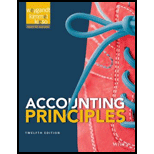
Concept explainers
Worksheet: Worksheet is a multiple-column form, which is used in the adjustment process and for preparing the financial statements of the company. It is not a permanent accounting record.
Supplies: Supply refers to the general stationery utilities use by the company and Supplies account always has a debit balance. So, it should be extending in the worksheet accordingly: Adjusted
Accounts payable: It refers to the short-term liabilities of the company, which arises due to purchase of goods on credit and liabilities are always of credit in nature. So, it should be extending in the worksheet accordingly: Adjusted trial balance credit column; and balance sheet credit column.
Common stock: Common stock is the part of the stakeholders’ and indicates the ownership. It is always of credit in nature. So, it should be extending in the worksheet accordingly: Adjusted trial balance credit column; and balance sheet credit column.
Dividend: It refers to that amount of profit which is paid to the stockholders by the company. This account has a debit balance. So, it should be extending in the worksheet accordingly: Adjusted trial balance debit column; and balance sheet debit column.
Depreciation expense: The expenses are always debit in nature. So, it should be extending in the worksheet accordingly: Adjusted trial balance debit column; and income statement debit column.
Service revenue: The revenue is always credit in nature. So, it should be extend in the worksheet accordingly. Adjusted trial balance credit column; and income statement credit column.
To indicate: Financial statement columns of the worksheet for the given accounts of adjusted trial balance.
Want to see the full answer?
Check out a sample textbook solution
Chapter 4 Solutions
Accounting Principles - Standalone book
- For the current year ending December 31, Rutherford Manufacturing expects fixed costs of $4,200,000, a unit variable cost of $14.75, and a unit selling price of $19.25. A) Compute the anticipated break-even sales (in units). B) Compute the sales (in units) required to realize income from operations of $650,000.arrow_forwardSubject: general accountingarrow_forwardwhat is the inventory turnover ratio?arrow_forward
- How many units must be sold to achieve this goal?arrow_forwardSummit Industrial forecasts that total overhead for the current year will be $8,500,000 and that total machine hours will be 150,000 hours. Year-to-date, the actual overhead is $5,600,000, and the actual machine hours are 75,000 hours. If Summit Industrial uses a predetermined overhead rate based on machine hours for applying overhead, what is the overhead rate? a. $50 per machine hour b. $65 per machine hour c. $56.67 per machine hour d. $45 per machine hourarrow_forwardAccounting problem with solutionarrow_forward

 AccountingAccountingISBN:9781337272094Author:WARREN, Carl S., Reeve, James M., Duchac, Jonathan E.Publisher:Cengage Learning,
AccountingAccountingISBN:9781337272094Author:WARREN, Carl S., Reeve, James M., Duchac, Jonathan E.Publisher:Cengage Learning, Accounting Information SystemsAccountingISBN:9781337619202Author:Hall, James A.Publisher:Cengage Learning,
Accounting Information SystemsAccountingISBN:9781337619202Author:Hall, James A.Publisher:Cengage Learning, Horngren's Cost Accounting: A Managerial Emphasis...AccountingISBN:9780134475585Author:Srikant M. Datar, Madhav V. RajanPublisher:PEARSON
Horngren's Cost Accounting: A Managerial Emphasis...AccountingISBN:9780134475585Author:Srikant M. Datar, Madhav V. RajanPublisher:PEARSON Intermediate AccountingAccountingISBN:9781259722660Author:J. David Spiceland, Mark W. Nelson, Wayne M ThomasPublisher:McGraw-Hill Education
Intermediate AccountingAccountingISBN:9781259722660Author:J. David Spiceland, Mark W. Nelson, Wayne M ThomasPublisher:McGraw-Hill Education Financial and Managerial AccountingAccountingISBN:9781259726705Author:John J Wild, Ken W. Shaw, Barbara Chiappetta Fundamental Accounting PrinciplesPublisher:McGraw-Hill Education
Financial and Managerial AccountingAccountingISBN:9781259726705Author:John J Wild, Ken W. Shaw, Barbara Chiappetta Fundamental Accounting PrinciplesPublisher:McGraw-Hill Education





